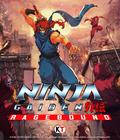
Genre: Action/RPG
Publisher: Atari
Developer: WebFoot Technologies
Release Date: June 17, 2003
Buy 'DRAGON BALL Z: Legacy of Goku II': Game Boy Advance
 I’m not a big fan of the Dragon Ball Z series. I’ve never played the original The Legacy of Goku GBA game, either. Gohan, Goku, Vegeta, and Piccolo are all names of Japanese side dishes, for all I knew. Sure, I’d watch the occasional episode on the Cartoon Network or endure a lengthy explanation of the show’s ongoing story by my nephews every now and then, but the series’ appeal never became clear to me. Now, after having played through The Legacy of Goku II, which attempts to purport 76 episodes worth of information in one tasty bite-sized 20-hour (potential) quest, I can certifiably call myself a fan. And now I know the different between a super-sized combo meal and a Super Saiyan, there’s hope for me yet.
I’m not a big fan of the Dragon Ball Z series. I’ve never played the original The Legacy of Goku GBA game, either. Gohan, Goku, Vegeta, and Piccolo are all names of Japanese side dishes, for all I knew. Sure, I’d watch the occasional episode on the Cartoon Network or endure a lengthy explanation of the show’s ongoing story by my nephews every now and then, but the series’ appeal never became clear to me. Now, after having played through The Legacy of Goku II, which attempts to purport 76 episodes worth of information in one tasty bite-sized 20-hour (potential) quest, I can certifiably call myself a fan. And now I know the different between a super-sized combo meal and a Super Saiyan, there’s hope for me yet.
Perhaps it’s better that I begin my journey into the world of Dragon Ball Z with The Legacy of Goku II. As I understand, the first adventure was something of a disappointment. “Too short,” “too rushed,” “not fun,” are just some of the feelings critics have expressed for the original game. By contrast The Legacy of Goku II sports a much longer quest covering everything from the Trunks Saga to the end of the Cell Games. It also features tons of side-quests and bonus goodies to keep players busy in addition to the comparatively larger adventure. But perhaps the best new addition to LoGII is the ability to play as not only the titular protagonist Goku but also Trunks, Vegeta, Piccolo, and Gohan. It will take a while to form the party in its entirety but the majority of the game is played with every character in tow. This addition accounts for plenty of the game’s appeal as switching between fighters is often a necessary strategy in order to visit every possible location, plus the character you play as also has an affect on the actual dialogue that transpires, making a good argument for increased lasting appeal.
One detrimental aspect of the original game according to popular critical opinion was the fact that the storyline and progression of the game was very linear, forcing you along a single path the entire time. This time around the same cannot be said as you are now given free reign over a 3D-style world map in which you can fly from location to location as you desire. There are just over a dozen or so unique areas in The Legacy of Goku II and as you progress through the game some of these locations will change; environments will reflect the different seasons of the year, weather effects are present, and tougher enemies will challenge you the stronger you get. If you’re the exploratory type you’ll be glad to know that extra credit is encouraged: wandering off the beaten path will often result in finding side-quest items (such as golden capsules, lost nameks, and other assorted goodies) or optional adventure opportunities.
The Legacy of Goku II is a mix of real-time combat and RPG elements (not unlike the SNES classic Secret of Mana). You’ll move your character around in different areas that are often littered with enemies - such as snakes, robots, four-legged woodland creatures, and mammoth fire-breathing, uh, things – and as you dispose of them using either simple punches and kicks or energy blasts you’ll gain experience and eventually level up. As you level up your character’s attributes (hit points, defense, energy points, et cetera) will accordingly increase. To say that combat in LoGII is basic would be a bit of an understatement; the B button shoots energy blasts (different energy blasts can be selected with the L trigger, though aside from their respective power, little differs) and the A button performs melee attacks, that’s all there is to it. The overwhelming (underwhelming?) simplicity of the game’s combat system is a bit of a downer, though battles are staged in such a manner as to take advantage of it and thus remain fun, finding a nice balance of challenge and fast-paced action.
The various tasks that you’ll need to perform to progress through the game change in method and style quite consistently. Though the tendency to walk/run through new areas disposing of baddies along the way is the main thing you’ll find yourself doing, the actual reasons you’ll be doing that change. For example, in one area you must explore a jungle environment in search of three power generators that you must destroy, which will remove the energy field blocking your way to the enemy’s main foothold. However, you’ll soon discover, after trashing the first generator, that things aren’t business as usual. As you come across the second generator you’ll notice a large dinosaur who has made it its home, using the generator’s heat to effectively incubate her eggs. So in return for moving to a different location (so that you can trash the generator) you agree to carrying the eggs to her new location, which is easier said than done since you’ll be unable to attack while carrying an egg and if you get attacked the egg will break and you’ll have to start over. It’s stuff like this that effectively changes the pace of the game and keep things feeling fresh.
From a visual standpoint Legacy of Goku II is right up there with the Golden Sun series, sans spiffy pseudo 3D and particle effects. The character sprites are pretty detailed and feature an assortment of different animations that will come into play during the frequent in-game cut-scenes. Environments range drastically in style from one another and they are all designed in such a way as to avoid unnecessary wandering thanks to easily noticeable trails that you can follow to get from point A to point B. Also, the map function, which can be summoned at any time by hitting the R trigger, is invaluable for those who wish to play the game with utmost efficiency. I wish every handheld RPG featured a map function as well thought out and functional as this one. The various bosses that you’ll go up against are quite large and detailed, instilling a genuine sense of dread as the momentum builds up to the actual fight with them.
The sound in The Legacy of Goku II does a great job of conveying a somewhat lighthearted though decidedly epic feel to the game. The music is a sort of mix between traditional RPG tunes and quirky electronic sounds. Songs tend to repeat when you’re in the same area for prolonged durations of time, though each song usually lasts an impressive three or four minutes before doing so. Sound effects do a good job of representing the on-screen action such as the sounds of projectile energy discharges and the swooshing of melee attacks.
Overall, I had a great time with Dragon Ball Z: The Legacy of Goku, and considering I’m hardly acclimated with the cartoon series that should say something to prospective consumers who are just looking for some solidly entertaining RPG action. I was able to beat the game in around 10 hours, forgoing the majority of bonus areas and side-quests, though fans of the series will undoubtedly get quite a bit more mileage out of the game. Fans of the cartoon and RPGs in general would do well to pick this game up.
Score: 8.4/10





























